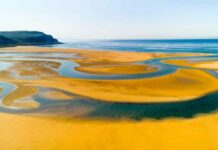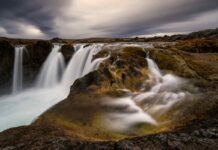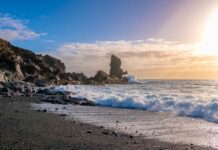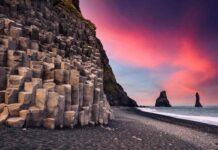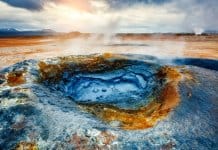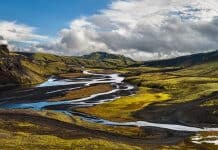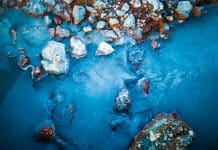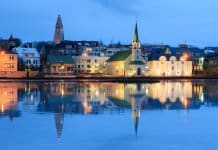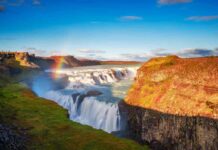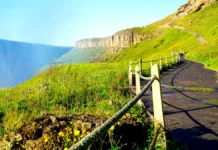Tucked away on the western coast of Iceland’s Snæfellsnes Peninsula, Djúpalónssandur beach is a breathtaking natural gem that offers visitors a fascinating blend of history, folklore, and stunning natural beauty. This black pebble beach is not only visually striking, but it also holds significant cultural value for Icelanders. Once home to a bustling fishing community, today it stands as a peaceful yet dramatic landscape, offering insight into Iceland’s seafaring heritage and geological wonders.
In this comprehensive guide, we will explore the enchanting world of Djúpalónssandur, touching on its history, natural features, and the attractions that make it a must-visit destination for anyone traveling to Iceland. Whether you’re a nature enthusiast, a history buff, or someone looking for a unique place to camp near Iceland’s coast, Djúpalónssandur will not disappoint.
What Makes Djúpalónssandur So Unique?
Djúpalónssandur beach is a black pebble beach, different from the typical sandy beaches you may be used to. Instead of sand, the beach is covered with small, smooth black pebbles, locally known as Djúpalónsperlur or “pearls of the lagoon.” These pebbles have been shaped by centuries of tidal forces, creating a natural mosaic that is both visually stunning and unique to this part of Iceland.
But there’s more to Djúpalónssandur than just its beauty. The beach has deep historical roots, particularly tied to the nearby cove of Dritvík, once one of Iceland’s largest fishing stations. The remnants of this fishing heritage, including rusted metal from a shipwreck, remain scattered across the beach, serving as a haunting reminder of the dangerous conditions fishermen once faced on the Icelandic seas.

Dritvík Cove and the Fishing Heritage
The Dritvík cove, located just a short walk from Djúpalónssandur, was a thriving fishing hub from the 16th to the 19th century. At its peak, it supported up to 600 fishermen working on around 60 boats. Despite the treacherous conditions of the North Atlantic, Dritvík was central to Iceland’s fishing economy for centuries.
Visitors to Dritvík and Djúpalónssandur can still see the remains of this historical era, including the foundations of stone huts where the fishermen stayed, and fragments of a British trawler that was shipwrecked off the coast in 1948. These relics are protected by Icelandic law, so it’s important to remember that visitors should leave them untouched.
The Black Pebbles of Djúpalónssandur
One of the defining features of Djúpalónssandur beach is the endless sea of smooth black pebbles that cover its surface. These pebbles have been naturally smoothed over thousands of years by the ocean’s constant ebb and flow, creating a unique texture that you won’t find on many other beaches in the world.
It’s also important to remember that taking these black pebbles as souvenirs is strictly prohibited by Icelandic law, as part of efforts to preserve the natural beauty and ecological balance of the area.
These black pebbles create a striking contrast with the towering cliffs that surround the beach, making it a popular spot for photographers and nature lovers alike.
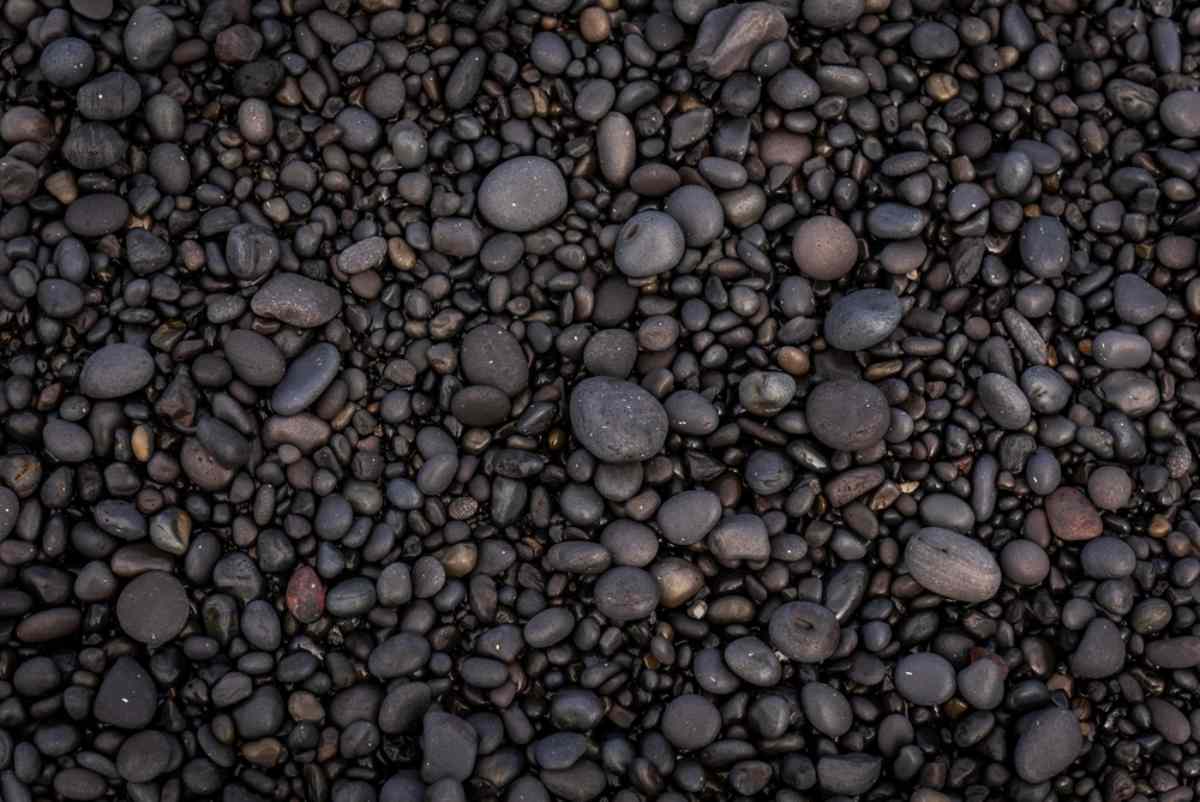
The Legendary Lifting Stones of Djúpalónssandur
One of the most intriguing aspects of a visit to Djúpalónssandur is the chance to test your strength against the ancient Icelandic lifting stones, which were once used by fishermen to assess their physical abilities. There are four lifting stones on the beach, each with a different weight:
- Fullsterkur (“Full Strength”) – 154 kg (340 lbs)
- Hálfsterkur (“Half Strength”) – 100 kg (220 lbs)
- Hálfdrættingur (“Weakling”) – 54 kg (119 lbs)
- Amlóði (“Useless”) – 23 kg (50 lbs)
The lifting stones were used as a test of strength to determine whether a fisherman was fit enough to join a boat crew. To be considered for the team, a fisherman needed to lift at least Hálfdrættingur, the third-heaviest stone, onto a ledge.
While the days of fishing teams are long gone, visitors can still try their hand at lifting these stones. Many tourists enjoy the challenge, attempting to measure their strength against Icelandic fishermen of the past.

The Shipwreck of the Epine GY7
As you walk along the beach, you’ll notice scattered remnants of a shipwreck. These pieces come from the British trawler Epine GY7, which was wrecked here in 1948. The twisted metal fragments are a reminder of how treacherous these waters can be. The wreckage, left untouched, creates a hauntingly beautiful contrast against the serene backdrop of the black pebble beach.
This shipwreck is one of many that dot Iceland’s coast, but it remains a poignant example of the dangers faced by those who ventured out onto the wild North Atlantic seas.

The Geological Wonders of Djúpalónssandur
Beyond its historical and cultural significance, Djúpalónssandur is a place of stunning geological beauty. The towering lava formations that frame the beach are a testament to Iceland’s volcanic origins. As you wander along the shoreline, you’ll pass by strange rock formations and cliffs shaped by millennia of volcanic activity.
One of the most striking geological features is Gatklettur, a large hole in a rock formation, shaped like a natural arch. This incredible formation offers fantastic photo opportunities, especially when the ocean crashes through the hole, creating dramatic splashes of water.
Snæfellsjökull National Park
Djúpalónssandur is located within the boundaries of Snæfellsjökull National Park, which is dominated by the magnificent Snæfellsjökull Glacier, a dormant volcano that last erupted over 1,700 years ago. This glacier is famously known as the setting for Jules Verne’s novel, Journey to the Center of the Earth.
The national park offers hiking trails and plenty of opportunities for outdoor enthusiasts to explore the area’s rich natural beauty, with Djúpalónssandur often being a highlight of the park.
Camping Near Djúpalónssandur
For those who want to fully experience the raw beauty of Djúpalónssandur, camping nearby is a fantastic option. There are several campsites within the Snæfellsnes Peninsula, making it easy to access Dritvík and Djúpalónssandur beach while enjoying the peace and solitude of the surrounding landscape.
Camping in this area offers a unique opportunity to immerse yourself in the Icelandic wilderness, but it’s essential to be aware of the camping rules in Iceland to ensure a responsible and eco-friendly experience. Proper preparation is key, especially given Iceland’s unpredictable weather and the rugged terrain of the region.

Frequently Asked Questions
Where is Djúpalónssandur?
Djúpalónssandur beach is located on the southern coast of the Snæfellsnes Peninsula in western Iceland, within Snæfellsjökull National Park. It is roughly a 2.5-hour drive from Reykjavik, making it a popular day trip destination.
How do I get to Djúpalónssandur beach?
To reach Djúpalónssandur beach, you can take Route 1 from Reykjavik and then switch to Route 54, which will take you through the stunning landscapes of the Snæfellsnes Peninsula. Follow signs for Snæfellsjökull National Park, and once there, you’ll find a parking lot near the beach with easy access to walking paths leading to the shore.
A unique stop in Iceland
Djúpalónssandur is more than just a black pebble beach; it’s a place where Icelandic history, mythology, and natural beauty come together to create a destination that feels both ancient and otherworldly. From the legendary lifting stones to the haunting wreckage of the Epine GY7, every corner of this beach tells a story. As part of Snæfellsjökull National Park, Djúpalónssandur is also a gateway to exploring Iceland’s incredible geology and volcanic heritage.
For those planning a road trip through Iceland, Dritvík and Djúpalónssandur beach are must-visit destinations that will leave a lasting impression. And if you’re ready to explore Iceland’s natural wonders, consider traveling in a campervan for the ultimate flexibility and convenience. Check out our campervan comparison to find the perfect vehicle for your Icelandic adventure!

